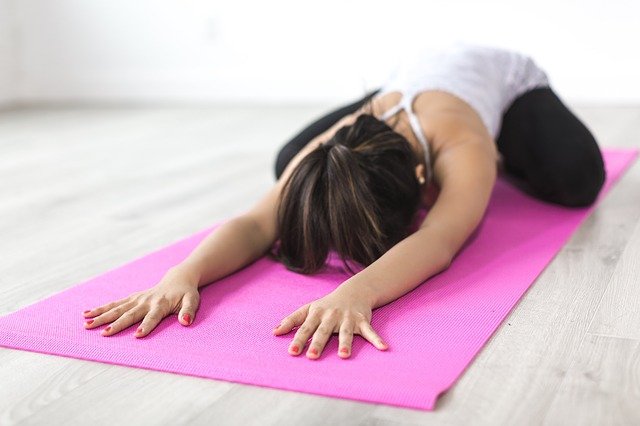Have you tried yin yoga?
It’s a modern form of yoga that infuses your body and mind with healing energy. It’s easy to do at home and can help you feel more flexible, energised and connected with your higher self.
However, if you’re new to yin yoga this may not be your experience – at first. That’s because it takes time and patience to adapt to yin yoga poses.
Let’s take a closer look at yin yoga and how it can help transform your health.

What Is Yin Yoga?
Yin yoga is a fusion of asanas and meditation.
It’s a slow, mindful practice that helps you move energy (life force) around your body. This is wonderful for physical, mental and emotional wellbeing.
Yin yoga involves arriving into a pose and holding it for 3 to 7 minutes. The intention is to relax completely into the yin pose, with no tension present in the body.
This can be a peaceful, meditative experience. Or, if you’re dealing with discomfort, it can be uncomfortable while your body warms up and the connective tissues relax.
Holding poses for this length of time helps to:
- Release mental chatter
- Allow yourself to be present in the moment
- Identify any physical sensations
- Relax into discomfort
- Notice if you have pain. If so, where is it coming from? Is there anything your body wants to tell you about the pain?
- Increase flexibility
- Massage the internal organs.
This process allows space for self-inquiry.
Anyone who practises yin will tell you this can be a transformational and transcendent experience.
Note: This is very different from traditional Yang Yoga, e.g. hatha, ashtanga, bikram. They’re more focused on getting a workout and building strength.
The Benefits of Yin Yoga
Yin yoga benefits your body, mind and spirit.
You can already see how its slow pace helps to calm the mind and bring clarity to your thoughts. This meditative practice also nourishes your spirit and connection to your inner self.
But, what about the body?
Why is it so great for physical health?
Yin yoga is like therapy for your joints, tissues and muscles.
It works with the myofascial meridians in the body to nourish the connective tissues.
Myofascial meridians are basically lines of connective tissue that run through your body. They allow you to move with flow and flexibility. But, they’re also involved if your movement feels painful, weak or unstable.
The good news is that yin yoga classes help to stretch and hydrate connective tissues around your joints. It does this by naturally stimulating hyaluronic acid (H.A.) in your body.
Hyaluronic acid is present in your joints, eyes and skin. It helps your joints to move smoothly and is vital for skin flexibility. H.A. is important for hydration too – just ¼ of a teaspoon of hyaluronic acid holds about 5 ½ litres of water.
These are the main reasons why you can use yin yoga for flexibility and get marvellous results.

Tips For Practising Yin Yoga At Home
You don’t need to attend a Bernie Clark or Paulie Zink class to get the benefits of yin yoga. It’s something you can do in the comfort of your home.
According to Sarah Powers, the founder of Insight Yoga Institute, there are 3 principles (tattvas) of a yin yoga practice. Learn these, and then you can practise yin without a yoga instructor.
-
Come into the pose to an appropriate depth
Be mindful of your body’s sensations each time you enter a yin pose. Move into it until you feel only a little resistance. Give your body time and space to warm up, so that you can progressively move deeper into the pose. Most people find it takes about 30-seconds to 1-minute to reach the next level of depth. Although, some people need to practise yin for a while before this is possible. Always listen to your body and respect what it’s telling you.
-
Surrender to stillness
Once you reach depth within a pose, it’s time to surrender to stillness in your body, breath and mind. Commit to not moving, no matter how much your mind wants you to. There are, however, some exceptions:
- You’re in pain. This is a sign you’ve pushed things a little too far. Discomfort is fine, even normal, but pain is not. It’s best to shift your position if the pose causes you pain.
- Your body has opened up and is inviting you deeper. If you notice your muscles have relaxed and feel that you can go deeper into the pose, do so. Increase your depth slightly so you remain within your healthy limits.
- You’re inspired to explore the pose. Feel free to explore variations of the pose if your body – not your mind – is calling you to.
-
Hold the pose for time
By now you’re deep into the pose and surrendering to stillness. All that remains is to commit to holding it for a few minutes. This is how you get the benefits of yin yoga – that magnificent increase in hyaluronic acid production. Remember that yin tissues aren’t elastic and don’t respond well to constant movement. Instead, they want to be nurtured and stimulated by holding your position over a period of time.
This video will help you get started practising yin yoga at home:




